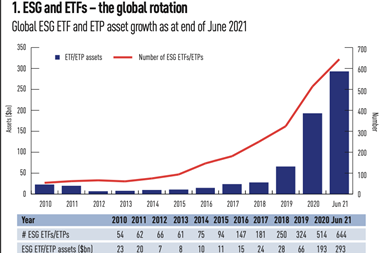Continued demand from institutional investors, including active asset managers, will help fuel a near tripling of global bond exchange-traded fund (ETF) assets to reach $5trn by 2030, according to BlackRock.
BlackRock pioneered bond ETFs 20 years ago, via the iShares business, and the market has since seen 23% annual growth to reach $1.7trn, and more than 1,400 products.
Three years ago, as the global bond ETF industry approached $1trn assets under management, BlackRock forecast that it would double by the end of 2024. This week it said it believed it would reach $2trn in 2023, 18 months “early”, despite currently challenging macroeconomic conditions.
At $5trn in assets under management, global bond ETF penetration would amount to around 5% of global fixed income market, less than half ETFs’ share of global equities, BlackRock noted.
“The global bond ETF industry is growing faster than we expected, propelled by self-reinforcing and enduring adoption trends from our clients during the pandemic era,” said Carolyn Weinberg, global head of product for ETF and index investments at the asset manager.
“We believe that the next wave of growth is just beginning.”
She said much of this growth would come from increased adoption of existing products, but that innovations that incorporate more active management will also play a role.
BlackRock said investors were implementing advanced strategies incorporating active management alongside traditional bond ETFs, individual bonds and other fixed income instruments, and that it expected this “next generation” of more active bond ETFs could reach $1trn in assets under management by 2030, up from about $200bn today.
Other trends that will help drive further adoption of bond ETFs, according to BlackRock, include the take-up by institutional investors, from pension funds to active managers. It said scores of institutional clients had bought bond ETFs for the first time in 2020 and since then, many had found new ways to use bond ETFs.
According to a survey by Brown Brothers Harriman in January, 65% of institutions globally have allocated more than 30% of their portfolio to bond ETFs.
BlackRock also said it had observed an increasing number of wealth investors looking to diversify risk assets at the portfolio level with simple bond “barbell” strategies consisting of broad, index bond ETFs and actively managed fixed income mutual funds that seek non-correlated returns.
It also said there were tailwinds for institutional adoption of bond ETFs in the US, with the the New York State Department of Financial Services last year amending its rules in way that bond ETFs on a more level playing field with individual bonds.
Another factor fuelling BlackRock’s upgraded forecast is its observation that the growth of bond ETFs and their ecosystem has helped drive advances in electronic trading and algorithmic pricing of individual bonds.
“Bond ETFs have overcome many tests, and they have become the catalyst of a more modern, more digital and more transparent bond market,” said Salim Ramji, global head of ETF and index investments at BlackRock.
Read the digital edition of IPE’s latest magazine
















No comments yet